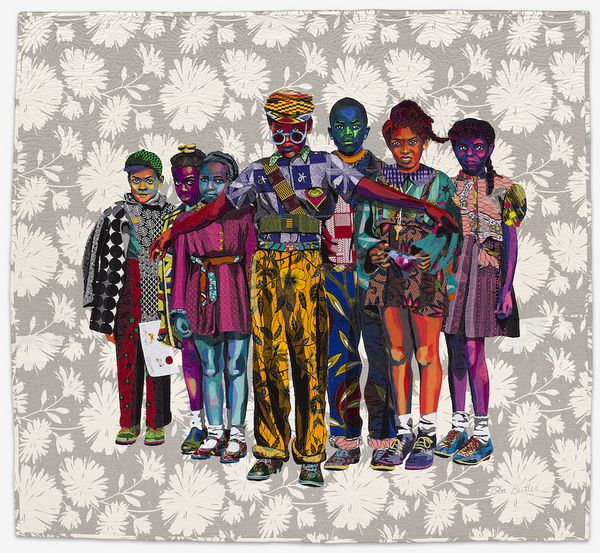Bisa Butler. Southside Sunday Morning, 2018. Private collection. © Bisa Butler. Photo by Margaret Fox.
PHILLIPS: The exhibition, "Bisa Butler: Portraits" is the first solo museum exhibition for this rising artist. Can you please tell us a bit about her background?
ERICA WARREN: Bisa studied painting as an undergraduate at Howard University. Although committed to art, she recognized that painting might not be the medium that best expressed her vision or suited her life. The advice of an undergraduate professor guided her towards experiments with fabric and she explored these materials in greater depth during a fiber class, taken as part of her master’s studies at Montclair State University. For this class, Bisa made her first portrait quilt, Francis and Violette, based on her maternal grandparents’ wedding photograph.

Bisa Butler, Anaya with Oranges, 2017. Dimmitt Davies Collection. © Bisa Butler. Photo by Margaret Fox.
P: Can you talk more about the medium of this work as it related to the tradition of storytelling in American quilt‐making?
EW: Quilters have long used their work to tell stories about family, affirm friendships, celebrate love, mourn losses, give thanks, mark time, and even prepare for the unknown. Bisa’s work celebrates and continues this history. Her use of vintage photographs, which most often serve as the starting point for a work, foster a close connection between artist and subjects as she layers material to flesh out their forms, incorporating colors and patterns that narrate and contemplate a life story for the individuals she portrays.

Bisa Butler, The Safety Patrol, 2018. Cavigga Family Trust Fund. © Bisa Butler.
P: What are some of the details in the portraits that you are particularly drawn to?
EW: There are so many marvelous details! Each quilt rewards close, slow looking. In The Safety Patrol, I take particular note of the school assignment that the little girl at center left holds in her hand. The paper bears her name “Ruth” and the day’s date “Sept 13.” The fact that she holds fast to this shows that she takes pride her work and wants to share her accomplishments with others. The details of the children’s clothing, such as the cool blue sunglasses of the central boy, his kente patrol belt, and the watchful eye on his shirt pocket, all contribute to the quilt’s narrative.
The artist’s attention to detail also comes across in Southside Sunday Morning, in which each of the five boys, attired in their Sunday best, vibrate with energy. The bespectacled boy at far left has a pink rose in his jacket lapel and a string extends from the flower to his hat brim. Bisa researched this detail, which appears in the photograph that inspired the work, and learned that this accessory was designed to keep his hat from blowing away entirely in a swift wind. In each work, special details from buttons to shirt collars, and hairstyles to facial expressions convey the varied complexities of her subjects’ ordinary lives.

Bisa Butler, The Princess, 2018. Collection of Bob and Jane Clark. © Bisa Butler. Photo by Margaret Fox.
P: The Art Institute acquired a portrait by Butler for the permanent collection. How do acquisitions such as this one further the museum's broad collection?
EW: The Art Institute acquired The Safety Patrol last year and it provides myriad opportunities for engagement with works across the collection. During her studies at Howard, Bisa absorbed the philosophies of AfriCOBRA artists, such as Barbara Jones‐Hogu, she looked to Romare Bearden’s multi‐media collages to inform her material experiments, and she also has embraced Gordon Parks’ documentary strategy in considering and selecting her subjects. All of these artists have works in the Art Institute’s collection, and the interdisciplinary concerns of Bisa’s textile‐based practice open up countless possibilities for making cross‐material connections.
Moreover, this acquisition strategically builds on the museum’s substantial quilt collection, which includes more than two hundred objects spanning a period of over two hundred years, from an early nineteenth‐century appliquéd quilt to a late twentieth‐century pieced and painted portrait quilt by Faith Ringgold. The Safety Patrol provides avenues to examine the history of quilt making, quilt collecting, and quilt history while offering a hopeful vision for the future.

Recommended Reading
From Our Museum Partners: Looking Forward >
Director John W. Smith on What's Next for the RISD Museum >
